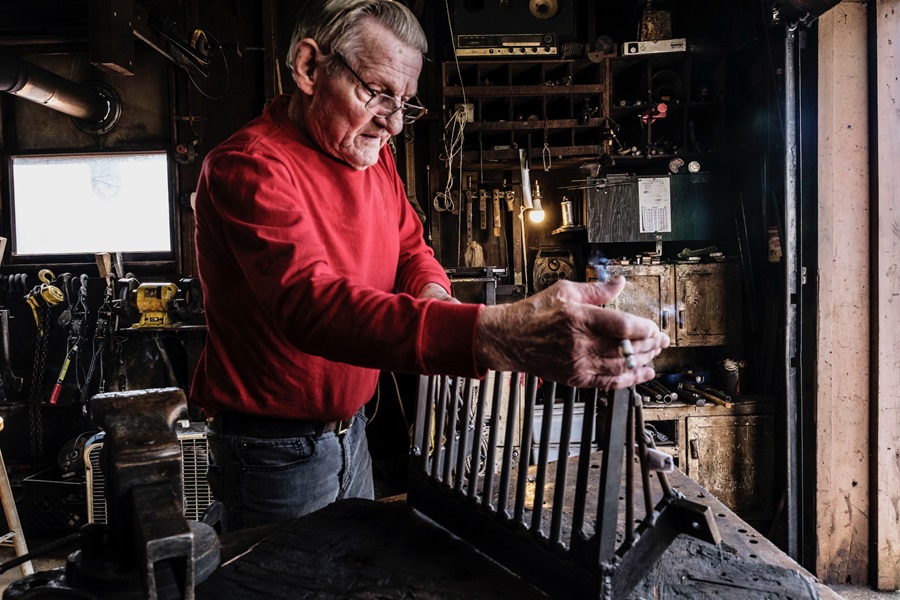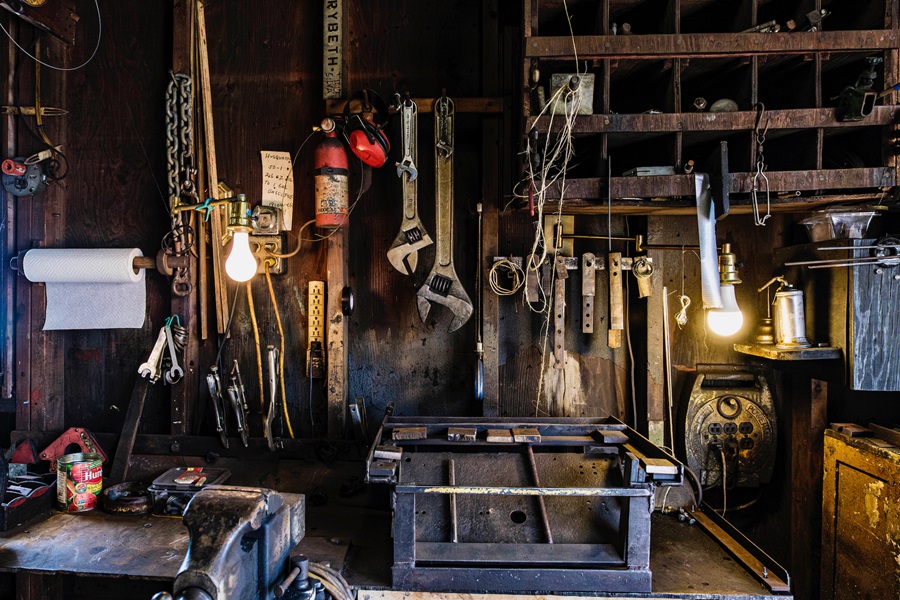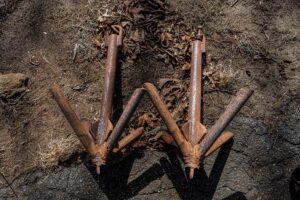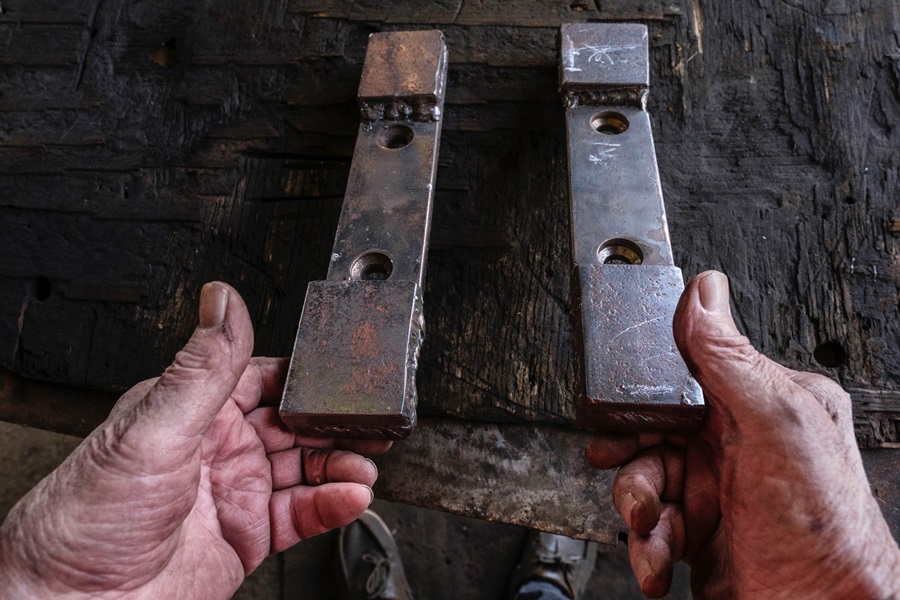ORLEANS — On a rusty table fashioned from what once held the shaft of a windmill, Al Youngren sketches the outline of a scallop dredge with a piece of white chalk. “The drag on the bottom goes like this,” he says, angling his knuckles as he slices through the air with his hand.
Next, he draws the triangular steel frame that winches a chain-mail bag filled with scallops up to the deck, scribbling in two “shoes,” small steel bars that ride along the bottom to limit environmental damage as the dredge travels across the seafloor.

Youngren moves quickly through this lesson for a washashore. He knows these dredges intimately: for decades, he used them in his work on board clam and scallop boats. Later, he fabricated them for other local fishermen. He’s still crafting their various accoutrements.
Born in Orleans, Youngren got his first job on a scallop boat out of New Bedford when he was 15. That was 1953. He learned to repair fishing gear during offshore expeditions that lasted up to 10 days, he says. Those skills must have been in demand. He worked on the F/V Stevin R. and on the Gerda Riva out of Provincetown and the F/Vs Friendship, Mary B., and Melanie Marie out of Wellfleet, among other vessels, he says.
With his fishing days largely behind him, Youngren has come by local fame for another reason. By many estimates, he is one of last makers of the “Cape-style” scallop dredge living on this part of the Cape.
“A lot of guys call it the ‘Al drag,’ ” says Tor Bendiksen of Reidar’s Manufacturing, a trawl gear and marine supply company in New Bedford that makes Cape-style dredges. These weren’t crafted by Youngren, but they were created based on modifications Youngren made to the usual New Bedford-style model.

The latter were designed for raking mudflats in places like Long Island Sound, but Youngren’s modifications made a better dredge for sandy-bottomed seafloors, Bendiksen says. The frame of a Cape-style dredge is lighter and defter, he says, so it can “ski across the bottom,” sifting through top layers of sand “versus digging in hard.”
When Youngren retired from producing custom dredges by hand about a decade ago, he gave his dimensions and modifications to Reidar Bendiksen, Tor’s father, who had been one of his crewmates. Bendiksen says that, for the most part, the drag is exactly the same as the one Youngren spent his career making.
Youngren went full time into the gear business about 20 years ago, when a heart attack forestalled his work on the water. He started ordering hot rolled rounds to ship directly to his Orleans home in 2004 from Turners Steel Co. in Plymouth County. These he would mold into the frames for his dredges.
Youngren did not invent the Cape-style dredge, he says, though he helped to refine its contemporary design. He knew to model his style after the dredge designs of the late Peter Bruce, a welder who had an Eastham shop in the 1950s, when Youngren was a young fisherman.

While the triangular frame of a New Bedford dredge is welded from square steel tubes, Bruce welded from rounds, making his dredges lighter. Welders on the Outer Cape would always use the round, because that’s what Peter Bruce did, Youngren said. That’s what Youngren did when he started making his own drags.
Bendiksen describes a few other adjustments Youngren made, most notably a taller “hi-boy” frame suited to the four-inch rings now used for scallop chain-mail dredge bags.
He used to fetch about $3,000 for a custom-made scallop dredge, Youngren says. In his records, he counts 35 fishing vessels based in Provincetown whose dredges he constructed.
Though demand for the “Al drag” is driven primarily by fishermen in Provincetown and Wellfleet, Youngren says he’s made dredges for scallopers as far away as the Jersey Shore.
Youngren rarely works on 10-foot scallop dredges anymore, but he keeps busy with smaller projects, namely quahog dredge blades and shoes requested by local fishermen.
Such steely flotsam litters the corners of Youngren’s shop, a converted garage where he works for hours at a time, keeping warm with a wood-burning stove. The shelves are lined with winch-hoisting cables and wrenches, hooks, and old fishing lanterns. Overlooking his work on the back wall are three visages of horses — his grandmother’s paintings, darkened by years in the shop.

Youngren lays his hands over two shoes crafted for a bay scallop dredge. “A shoe is what a dredge wears,” he says. “The drag lays on that shoe when it’s on the bottom, so the shoe wears out, not the dredge.”
It was his idea to craft removable shoes for dredges — an innovation that makes sense locally, in this case for dayboat scallopers. “In New Bedford, they weld new shoes on,” Youngren says. “When they wear out, you’ve got to have a welder come down, bring his truck, and weld on new shoes. I bolt them, so when they wear them out, they can just change shoes in about five minutes.”
Youngren’s first experiment in making a blade for a quahog dredge was as a favor for Wellfleet fisherman David Ziemba, who had bent his while making a delivery. “I said, here, how about me making one of them for you?” Youngren recalls. After that, he says, Ziemba began to land more clams than he used to. Word spread about Youngren’s ability to position a blade at just the right angle for quahogging, and “next thing you know, I started getting phone calls: ‘Hey, Al, make me a blade,’ ” he says.
He’s still making gear — “not that I have to,” he says, “but because I want to.” He knows having gear ready at his shop can save fishermen days of waiting for replacements. “They call and say, ‘I got to have a new blade.’ I just say, ‘Come get it.’ ”



